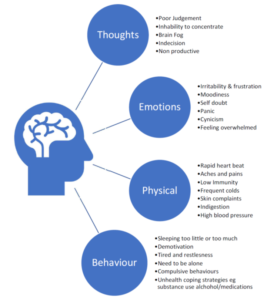Latest from HRi
Managing Anxiety Through Workplace Transitions
Guest blog from HRi member Gail Henderson of Kennedy Henderson – HR Consultancy and Business Psychology
For many people, their emotional health and wellbeing has been challenged as a direct result of remote working, phased re-entry and trying to cope with living through the pandemic.
Employers face the challenge of initiating a targeted response to the rapid increase in reported rates of workplace mental health conditions because of remote working and planned work-re-entry (CIPD,2020; MIND, June 2020).
The Health and Safety Executive (HSE)’s Labour Force Survey on employee mental health, found 49% of all working days lost in 2016/2017 were due to work-related stress, depression or anxiety. The HSE reported an increase in these figures in 2019/20, where stress, depression or anxiety accounted for 51% of all work-related ill health cases and 55% of all working days lost due to work-related ill health.
Many businesses will continue to operate remotely, and this coupled with the accelerated shift towards hybrid working, has had a significant impact upon employee’s mental health. The charity Mind found that 60% of adults reported a decline in their mental health during lockdown. The survey also found that employees with pre-existing mental health conditions were particularly affected and those who had been furloughed reported a slight decline in their mental health and wellbeing (Mind, June 2020). This trend is set to continue, according to a KPMG (2021) survey of CEOs, which reported that 17% of business leaders said they would reduce their office space, and 30% said they plan to have the majority of employees working remotely 2-3 days per week.
As HR professionals, we should consider that navigating the workplace can be difficult for employees dealing with anxiety. More importantly, the typical signs of anxiety may be more difficult to spot in employees working from home or more flexibly.
Causes of Anxiety
Rethink Mental Illness, a mental health charity, confirms that there are at least four main factors that can cause anxiety, including genetics, life experience; such as bereavement or job loss, drugs including caffeine, alcohol and medication and circumstances.
A study by ACAS (May, 2019) found the greatest challenge to positive mental health in the workplace are organisational change, line management capability together with downsizing and work intensification. Perkbox’s 2020 report found that: work-related office politics (37%); lack of interdepartmental communications (34%); and the work performance of others (33%) increased employee stress.
Verywell Mind (2020) also confirm that work can appear to be overwhelming to some employees and includes dealing with workplace bullying or conflicts; deadlines; managing staff; working long hours; demanding boss; workload overload; and lack of job control or direction.
Types of Anxiety
According to Rethink Mental Illness charity, some of the most common types of anxiety include:
Generalised anxiety disorder (GAD) – Worrying a lot about a lot of different things, which may persist for a long time.
Panic disorder – People with panic disorder have frequent and unpredictable panic attacks, which can be terrifying and can sometimes feel as if they are having a heart attack.
Social Anxiety disorder – People with social anxiety disorder worry that other people will judge them in social settings. As a result it is harder for them to network, to give a presentation, and even speaking up in a meeting.
Signs and Symptoms of Anxiety
Anxiety symptoms can be wide ranging, and can include shortness of breath; intense fear; chest palpitations; some phobias; panic attacks; or obsessive-compulsive disorders (OCD).
The possible signs that an employee many be experiencing anxiety at work may include:
- feeling tired, anxious and withdrawn;
- an increase in sickness absence or lateness;
- changes in work output; less interested in tasks;
- changes in mood or behaviour at work (ACAS, Coronavirus and mental health at work).
An employee may experience a range of mental or physical symptoms of anxiety, some of which are highlighted in the diagram (adapted from Healthline: Effects of anxiety on the body July 2018):

Managing Employee Anxiety
Employers need to identify the root causes of stress and anxiety in their workplace and introduce strategies to ensure the health and wellbeing of employees is maintained.
Research suggest that current organisational practices require guidance on how to manage the complex changes to working lives. McDowell and Kinman (2017), in “The new nowhere land? A research and practice agenda for the “always on” culture”, recommend that employers may support remote workers through communication, encouragement, and role-modelling healthy behaviours e.g., promoting teamwork and collaboration. Employees can also support themselves by learning how to manage their own wellbeing, set and communicate their boundaries between work and home life, and keep in touch with colleagues.
The CIPD have published a useful guide, Coronavirus (COVID-19): Mental health support for employees, which outlines considerations and provides advice on how mental health can be supported during the COVID-19 pandemic.
ACAS also recommends that employers should arrange mental health training for managers and staff; appoint mental health champions whom employees can talk to; and promote existing health and wellbeing initiatives.
Statutory Requirements
Employers have a ‘duty of care’ under Health and Safety Legislation to do all they reasonably can to support employees health, safety and wellbeing, including:
- making sure that employees can work safely and healthily;
- employees are protected from discrimination e.g. making sure reasonable adjustments are made; and
- that risk assessments are conducted to ensure workplaces are kept Covid secure and to provide safe systems of work.
Key takeaways
Research suggests that remote working in some cases, has had an adverse impact upon employee mental health and wellbeing. Whilst many employers welcome the easing of lockdown restrictions, this may have triggered a rise in anxiety and stress for many employees returning to work.
Research highlights many new areas of concern for employers and reinforces the importance of establishing strategies that will provide relevant resources for their employees, to manage mental health and stress within their organisation.
According to KPMG (2021), 50% of organisations now plan to increase their HR resources to help manage employee wellbeing and mental health, in addition to 14% that will consider creating shared office spaces, to increase workplace flexibility for employees.
As HR Professionals, we are in a strong position to support employers to help increase their awareness of recognising and managing the signs and symptoms of workplace anxiety. We need to be clear about our role boundaries in detecting and managing workplace anxiety and confident to know when to provide employees with advice and guidance on accessing support and services from other specialist health care professionals, e.g., Occupational Health. In supporting employees through workplace transitions, this may lead to improvements in employee’s wellbeing and improve company performance over time.
Author:
Gail Henderson
Kennedy Henderson – HR Consultancy and Business Psychology
